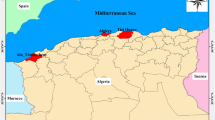Abstract
Levels of lead (Pb) and cadmium (Cd) were investigated as potential stressors in nine species of breeding seabirds on Marion Island, South Africa. The majority of blood Pb levels (95 %) were below background exposure levels. Species was a significant factor in ranked means analysis for mean blood Pb levels. Fewer individual blood Cd levels (<60 %) were within background exposure levels and species was not significant. Elevated levels of Cd have been documented in other seabird species without apparent outward effects, which suggests that seabirds may be adapted to high cadmium environments, particularly from their diets. Overall, the results suggest Pb and Cd are not primary causes for concern in these seabirds.
Similar content being viewed by others
References
Abouchami W, Galer SJG, de Baar HJW, Alderkamp AC, Middag R, Laan P, Feldmann H, Andreae MO (2011) Modulation of the Southern Ocean cadmium isotope signature by ocean circulation and primary productivity. Earth Planet Sci Lett 305:83–91
Adams NJ, Brown CR (1989) Dietary differentiation and trophic relationships in the sub-Antarctic penguin community at Marion Island. Mar Ecol Prog Ser 57(3):249–258
Anderson ORJ, Phillips RA, Shore RF, McGill RAR, McDonald RA, Bearhop S (2010) Element patterns in albatrosses and petrels: influence of trophic position, foraging range, and prey type. Environ Pollut 158:98–107 (Oxford, UK)
Barnes KN (1998) The important bird areas of southern Africa. BirdlLife International, Johannesburg
Bull K, Murton R, Osborn D, Ward P, Cheng L (1977) High levels of cadmium in Atlantic seabirds and sea-skaters. Nature 269:507–509
Burger J, Gochfeld M (2001) Metal levels in feathers of cormorants, flamingos and gulls from the coast of Namibia in southern Africa. Environ Monit Assess 69:195–203
Burger J, Pokras M, Chafel R, Gochfeld M (1994) Heavy metal concentrations in feathers of common loons (Gavia immer) in the Northeastern United-States and age differences in mercury levels. Environ Monit Assess 30:1–7
Bustamante P, Caurant F, Fowler SW, Miramand P (1998) Cephalopods as a vector for the transfer of cadmium to top marine predators in the north-east Atlantic Ocean. Sci Total Environ 220:71–80
Crawford R, Cooper J (2003) Conserving surface-nesting seabirds at the Prince Edward Islands: the roles of research, monitoring and legislation. Afr J Mar Sci 25:415–426
Davis LS, Renner M (2003) Penguins. Yale University Press, New Haven
Dorneles PR, Lailson-Brito J, Dos Santos RA, Silva da Costa PA, Malm O, Azevedo AF, Torres JPM (2007) Cephalopods and cetaceans as indicators of offshore bioavailability of cadmium off Central South Brazil Bight. Environ Pollut 148:352–359 (Oxford, UK)
Franson JC, Pain DJ (2011) Lead in birds. In: Beyer WN, Meador JP (eds) Environmental contaminants in biota: interpreting tissue concentrations, 2nd edn. Taylor and Francis, New York, pp 563–593
Furness RW (1996) Cadmium in birds. In: Beyer WN, Heinz GH, Redmon-Norwood AW (eds) Environmental contaminants in wildlife: interpreting tissue concentrations. CRC Press, Boca Raton, pp 389–404
Furness R, Camphuysen C (1997) Seabirds as monitors of the marine environment. ICES J Mar Sci 54:726–737
Gonzalez-Solis J, Sanpera C, Ruiz X (2002) Metals and selenium as bioindicators of geographic and trophic segregation in giant petrels Macronectes spp. Mar Ecol Prog Ser 244:257–264
Grindley JR, David P (1985) Nutrient upwelling and its effects in the lee of Marion Island. In: Siegfried WR, Condy PR, Laws RM (eds) Antarctic nutrient cycles and food webs. Springer, New York, pp 46–51
Martin JH, Broenkow WW (1975) Cadmium in plankton: elevated concentrations off Baja California. Science 190:884–885
Muirhead S, Furness R (1988) Heavy metal concentrations in the tissues of seabirds from Gough Island, South Atlantic Ocean. Mar Pollut Bull 19:278–283
Osborn D (1978) Naturally occurring cadmium and zinc binding protein from liver and kidney of Fulmarus glacialis, a pelagic North Atlantic seabird. Biochem Pharmacol 27:822–824
Osborn D, Harris M, Nicholson J (1979) Comparative tissue distribution of mercury, cadmium and zinc in three species of pelagic seabirds. Comp Biochem Physiol Part C: Pharmacol Toxicol Endocrinol 64:61–67
Pilastro A, Congiu L, Tallandini L, Turchetto M (1993) The use of bird feathers for the monitoring of cadmium pollution. Arch Environ Contam Toxicol 24:355–358
Smith VR (1987) The environment and biota of Marion Island. S Afr J Sci 83:211–220
Szefer P, Pempkowiak J, Skwarzec B, Bojanowski R, Holm E (1993) Concentration of selected metals in penguins and other representative fauna of the Antarctica. Sci Total Environ 138:281–288
Vega CM, Siciliano S, Barrocas PRG, Hacon SS, Campos RC, do Couto Jacob S, Ott PH (2010) Levels of cadmium, mercury, and lead in magellanic penguins (Spheniscus magellanicus) stranded on the Brazilian coast. Arch Environ Contam Toxicol 58:460–468
Wayland M, Scheuhammer AM (2011) Cadmium in birds. In: Beyer WN, Meador JP (eds) Environmental contaminants in biota: interpreting tissue concentrations, 2nd edn. Taylor and Francis, New York, pp 645–666
Wilson HM, Petersen MR, Troy D (2004) Concentrations of metals and trace elements in blood of spectacled and king eiders in northern Alaska, USA. Environ Toxicol Chem 23:408–414
Acknowledgments
We are grateful for the assistance of our contributors and editors including Dr. Robert Powell, Clemson University. We thank our research institutes for their support. This work serves as a contribution to the Seabird Health Survey organized by the Southern African Foundation for the Conservation of Coastal Birds (SANCCOB).
Author information
Authors and Affiliations
Corresponding author
Rights and permissions
About this article
Cite this article
Summers, C.F., Bowerman, W.W., Parsons, N. et al. Lead and Cadmium in the Blood of Nine Species of Seabirds, Marion Island, South Africa. Bull Environ Contam Toxicol 93, 417–422 (2014). https://doi.org/10.1007/s00128-014-1359-6
Received:
Accepted:
Published:
Issue Date:
DOI: https://doi.org/10.1007/s00128-014-1359-6




